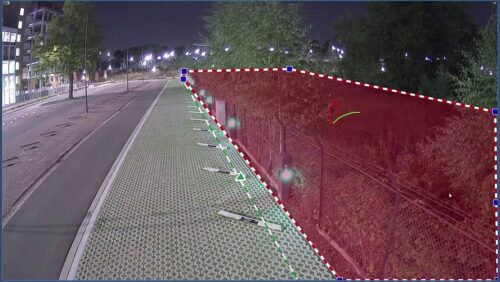
8.1.23 – Security Today – By Danny Youngerman
In an ever-evolving world, the need for robust and cost-efficient perimeter security measures has become paramount. Traditional methods often fall short of effectively safeguarding sensitive or large areas. However, a transformative technology has emerged, integrating AI with video monitoring systems to enhance perimeter security like never before.
This transformative video perimeter security technology differs from traditional security methods in several ways. The primary difference is that AI-based video perimeter security uses AI and machine learning algorithms to detect and alert security staff of potential threats. Traditional security methods rely on human observation and manual processes to detect and respond to threats. AI-based video perimeter security can be used to monitor large areas in real time and can detect potential threats more quickly and accurately than traditional security methods.
The purpose is not to eliminate the human element but to support or augment the relationship between humans and video in a way that refines and speeds up the review and response process.
While it is a relatively new technology, it has been rapidly adopted across many verticals due to a growing need for advanced security solutions.
Enhanced Detection Capabilities
One of the most important ways that video monitoring is revolutionizing perimeter security is enhanced detection. This has, traditionally, heavily relied on human detection skills.
Research consistently shows that humans lose 95% of their visual perceptivity after 20 minutes of reviewing video on one screen with the percentage dropping with each screen added. This is a phenomenon called “video blindness.” It happens because the human brain is just not made for long-term singular focus.
AI-based video monitoring introduces a new era of detection capabilities. Through real-time object recognition and classification, potential threats are identified with precision. Unauthorized persons, suspicious vehicles, and even unusual objects are efficiently flagged, ensuring proactive security measures. The system’s advanced motion detection and tracking enable continuous monitoring and swift response, effectively eliminating blind spots.
By harnessing AI’s power, security personnel are alerted in real-time, allowing for immediate action while significantly reducing false alarms.
Improved Response Time
When time is of the essence, AI-based video monitoring shines. Rapid threat assessment and prioritization are made possible through automated analysis of detected incidents. AI systems seamlessly integrate with existing security measures, facilitating quick response coordination.
Access control, alarms, and other security devices work in harmony, optimizing resource allocation based on real-time data.
Additionally, AI-driven decision support empowers security personnel with contextual information, enabling informed decision-making and suggesting appropriate response strategies aligned with predefined protocols.
Cost-effectiveness and Scalability
Efficiency and cost-effectiveness are major advantages of AI-based video monitoring for perimeter security. By reducing workforce requirements, AI-based automation minimizes the need for constant human monitoring thereby significantly reducing personnel costs. The ability of AI-powered cameras to cover vast areas ensures wide coverage with fewer devices, eliminating the need for excessive hardware investment. This technology also reduces the need for on-site guards as each camera has the power to become a virtual guard.
Additionally, as organizations grow or security requirements change, scalability options allow for easy expansion, making AI-based solutions adaptable and future-proof.
These cost-effective measures provide long-term savings, mitigating losses from theft, vandalism and unauthorized access.
Enhanced Analytical Capabilities
AI-based video monitoring provides security professionals with unparalleled analytical capabilities.
Massive amounts of video footage can be collected and analyzed, enabling the identification of patterns, trends, and potential risks over time. By using behavioral analytics, the system can recognize suspicious or abnormal behavior, granting early detection of potential security breaches.
In post-incident investigations, AI’s forensic analysis capabilities assist law enforcement agencies by facilitating evidence gathering and aiding in identifying and apprehending culprits.
Privacy and Ethical Considerations
As with any surveillance technology, privacy, and ethics must be carefully addressed. Responsible data handling is crucial, ensuring compliance with privacy regulations and implementing appropriate data security measures.
AI-powered systems incorporate anonymization and masking techniques to protect individuals’ identities, striking a balance between security needs and privacy concerns. Transparency and accountability are vital, with organizations clearly communicating the purpose and scope of video monitoring, as well as providing mechanisms for addressing privacy-related concerns.
The convergence of AI and video monitoring technology has ushered in a new era of perimeter security. AI-based video monitoring offers unparalleled advantages, including enhanced detection capabilities, improved response time, cost-effectiveness, scalability, and advanced analytical capabilities. These benefits enable organizations to safeguard their assets more effectively, mitigate risks, and respond swiftly to potential threats. As the world continues to evolve, embracing AI-based video monitoring for perimeter security is an investment in a safer and more secure future.
It is imperative for security professionals and organizations to explore and adopt this transformative technology to ensure comprehensive protection in today’s dynamic security landscape.
